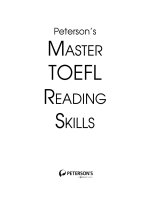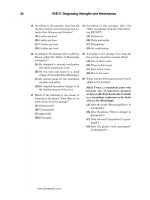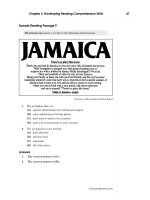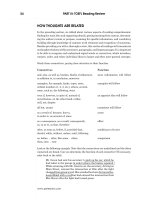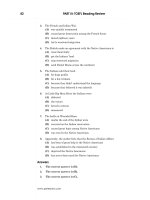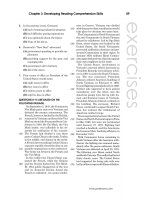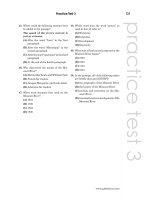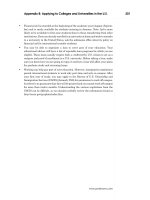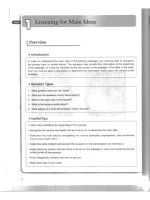READING JAPANESE - PART 1 pps
Bạn đang xem bản rút gọn của tài liệu. Xem và tải ngay bản đầy đủ của tài liệu tại đây (196.7 KB, 16 trang )
The Kanji Café’s
READING JAPANESE
THE JAPANESE KANA SCRIPTS
CONTENTS
eBook License 二 2
Introduction 三 3
Procedures 四 4
Lesson 1 (Katakana) 五 5 Lesson 5 (Hiragana) 八十八 88
Lesson 2 (Katakana) 十九 19 Lesson 6 (Hiragana) 百三 103
Lesson 3 (Katakana) 四十一 41 Lesson 7 - Not finished
Lesson 4 (Katakana) 六十三 63 Lesson 8 - Not finished
© 2007-2008 KanjiCafe.com
READING JAPANESE
二
eBook License
As long as you do not make alterations, feel free to disseminate this eBook.
The original text was written by Eleanor Harz Jorden with Hamako Ito Chaplin.
All other content was written by James Rose. It is a work in progress.
This eBook is published by Rolomail Trading, United States Virgin Islands.
The most up-to-date version of the book can always be found at KanjiCafe.com.
Jim can be reached at
Rolomail Trading can be reached at
This eBook was paid for by your support of Rolomail Trading. Thank you and keep it up!
READING JAPANESE
三
INTRODUCTION
This adaptation of READING JAPANESE contains four chapters which teach the katakana
syllabary, and four chapters which teach the hiragana syllabary. It has been formatted so that each
PDF page fits entirely on your screen. It is meant to be given freely without charge to promote the
study of the Japanese language. Reading Japanese was developed under contract with the U.S.
Office of Education, Department of Health, Education, and Welfare. This free version has been
republished by KanjiCafe.com, and was underwritten by the generous support of people like you,
who have purchased their Japanese educational products at the Rolomail Trading Company, and at
Mangajin Publishing (Wasabi Brothers Trading Company).
The Original textbook was prepared over a number of years, field tested in a number of
institutions, and was checked, typed, indexed and proofread by an extensive number of people,
hundreds of copies being sent out to participating schools for criticism and classroom reaction.
These schools, among others, included Bucknell University, Columbia University, the Foreign
Service Institute, University of Iowa, University of Pennsylvania, Yale University, the Japan
National Language Research Institute, and most especially Cornell University, where the authors
were from. This book is truly the result of an unusual level of cooperation.
READING JAPANESE is not a handbook or a dictionary, but was specifically prepared to
introduce adult foreigners, in particular English speakers, to the Japanese language, and enable
them to begin reading. Material is presented in an ordered fashion, and each increment of new
material presupposes mastery of what was studied before, but only what was studied before.
READING JAPANESE
四
PROCEDURES
Japanese is normally written with a mixture of two syllabaries (kana) and Chinese characters
(kanji). In kana writing, symbols represent syllables without reference to meaning, whereas
kanji regularly stand for sound plus meaning. More will be said about both systems later.
The first four lesson of this eBook introduce the katakana. Students should go through these
lessons, concentrating first on the reading and then the writing of each new symbol and the
examples provided. They should practice until all the Japanese material included (1) can be
read in random order, accurately, rapidly, and without any hesitation, and (2) can be written
accurately and rapidly, given either oral dictation of the Japanese, or the romanized equivalent
of the Japanese.
A final note: Those who conscientiously work through this text, following all recommended
procedures and moving ahead to a new lesson only after the previous lesson is adequately
internalized, can expect to acquire a solid basic foundation in Japanese reading. They will be
thoroughly familiar with all the katakana that have been introduced, through recurring contact
in assorted contexts, and they will be ready to move ahead into materials that add the hiragana
and kañji to their repertoire.
READING JAPANESE
五
LESSON 1
INTRODUCTION
The first four lessons introduce katakana, the syllabary used primarily for writing loanwords
(i.e., words borrowed from foreign languages). Katakana is also used to represent native
Japanese items that are intended to stand out in the context in which they occur. The use of
katakana in Japanese often corresponds to the use of italics in English: katakana occurs
frequently in advertisements; it is also used in writing items that represent something strange or
unusual from a linguistic point of view (for example, in quoting foreigners' errors in Japanese);
and it is often used in writing onomatopoeic words—i.e., those that are supposed to represent
their meaning by their sound (example: gatagata representing a rattling sound). In addition,
katakana is used in writing telegrams and, together with kañzi, in writing legal documents.
While most current linguistic borrowings by the Japanese is from English, there are many
loanwords derived from other languages. For example, among place names, Suisu 'Switzerland',
Itaria 'Italy', and Doitu 'Germany', all have non-English origins. The emphasis in the lessons that
follow, however, will be on the reading of Katakana as it is used to represent loanwords of
English origin. In particular, foreign place names and personal names will be used as examples
in the introduction of each new katakana symbol. The writing of kana should, of course, also be
mastered. After learning to read a symbol, students should practice writing, working back from
the romanization of the examples to the original kana.
READING JAPANESE
六
NOTES
When the Japanese borrow English words and phrases, these loanwords are pronounced in a
way that approximates the original pronunciation but conforms to the sound system of Japanese.
This entails many adjustments, since the sound systems of Japanese and English bear little
resemblance to each other. For example, because the sound system of English is more complex,
one Japanese sound often represents several sounds in English: Japanese b may represent
English 'b' or 'v'; Japanese oo may represent the vowel or dipthong of English 'stalk' or 'stoke';
Japanese si may represent English 'she' or 'see', and so on.
A further problem is the fact that while most borrowings are based on pronunciation, there are
often a variety of pronunciations for any given item in English, and some borrowings are derived
from the original English spellings. For example, Japanese aruminyuumu comes from British
English 'aluminium'; and English 'margarine' occurs in Japanese as maagariñ (ma-a-ga-ri-ñ)
conforming to its spelling rather than its pronunciation in English.
In loanwords, Japanese consonants as represented by romanization generally correspond to
the English consonants represented by the same letters in the writing system, although the actual
sounds the letters represent in the two languages are far from identical. Thus, r in Japanese is
used to represent the markedly different initial consonant of English 'road'. However, there will
also be many divergences from this kind of correspondence, partly because of the vagaries of
English spelling. For example, the 'c' of 'cent' is represented in Japanese as s, while the 'c' as
well as the 'k' of cake are represented by k. Other divergences, that result from the phonological
structure of Japanese, will be discussed below.
The most commonly occuring vowel correspondences are as follows.
READING JAPANESE
七
Japanese
corresponds to the English vowel or diphthong of:
i
ii
u
uu
e
ee or ei
o
oo
ou
oi
a
aa
ai
au or ao
'sit' (or 'seat')
'seed'
'look' (or 'Luke')
'mood'
'let' (or 'late')
'laid'
'cot' (or 'coat')
'mode' or 'Maud'
'mode'
'boy'
'pat' or 'pad' or 'putt'
'ma'
'my'
'cow'
In spite of all the adjustments required, katakana representing loanwords based on English
borrowings will, in most instances, be immediately identifiable to speakers of English as to its
origin. In some cases, however, identification is difficult, particularly for a student with only
limited experience in reading such items. When problems are encountered, the following
procedures (the procedures covered here apply to the examples introduced in this lesson) are
often helpful in providing clues that will make recognition possible.
READING JAPANESE
八
1. Write out the unidentified item in romanization.
2. Are there any short u vowels following consonants? Try eliminating them.
Examples:
misu = 'miss'
hosutesu = 'hostess'
3. Are there any r's? Check them out for representation of English 'l' as well as 'r'.
Examples:
arisu = 'Alice'
hoteru = 'hotel'
arasuka = 'Alaska'
sukuuru = 'school'
rookaru = 'local'
terii = 'Terry' or 'Telly'
rarii = 'Larry' or 'rally'
4. Are there any s's? Check them out for representation of English 'th' (as in 'thin') as well as 's'.
Examples:
sumisu = 'Smith'
ruusu = 'ruse' or 'loose' or 'Ruth'
And are there any Japanese si syllables? Check the consonant out for representation of
English 'sh' as well as 's'.
READING JAPANESE
九
Examples:
takusii = 'taxi'
siria = 'Syria'
rosia = 'Russia'
5. Are there any occurrences of aa ? Check them out for representation of English vowel + 'r' of
'far' or 'fir' (note the variety of English spellings that represent these sounds, in words such as
'bar', 'her', 'sir', 'fur', 'purr', 'hard', 'herd', 'bird', 'word', 'urban', 'lighter', 'color') as well as of long
'a'.
Examples:
misutaa = 'mister'
raitaa = 'lighter'
miraa = 'Miller'
tawaa = 'tower'
kuraaku = 'Clark' or 'clerk'
kaaru = 'Karl'
karaa = 'color'
mootaasukuutaa = 'motorscooter'
Additional procedures will be furnished in subsequent lessons. However, the student must
always bear in mind that the Japanese word-borrowing system is not completely regular: it is
usually possible to predict exactly how an English item will be borrowed into Japanese, but there
are exceptions. Fortunately, even the exceptions usually contain enough evidence of regularity to
make possible the identification of the English source, given the Japanese, and this is sufficient for
reading.
READING JAPANESE
十
SYMBOLS AND EXAMPLES
Katakana symbol:
Romanization
Stroke Order
ス
su
ミ
mi
ー
(vowel lengthening)
1
Examples:
スミス sumisu 'Smith'
ミス misu 'Miss'
ミス・
2
スミス misu
・
sumisu 'Miss Smith'
スー suu 'Sue'
スー・スミス suu・sumisu 'Sue Smith'
ミス・スー・スミス misu・suu・sumisu 'Miss Sue Smith'
1
In vertical writing, this symbol is written as a vertical line.
2
The dot represents a boundary between items. It regularly occurs between foreign given names and family name, but in general its
usage tends to be unpredictable.
READING JAPANESE
十一
Katakana symbol:
Romanization
Stroke Order
ア
a
メ
me
リ
ri
カ
ka
Examples:
アメリカ amerika 'America' ミス・アメリカ misu・amerika 'Miss America'
リー rii 'Lee' メリー merii 'Mary'
メリー・リー merii・rii 'Mary Lee' スー・リー suu・rii 'Sue Lee'
リー・スミス rii・sumisu 'Lee Smith' メリー・スミス merii・sumisu 'Mary Smith'
アリス arisu 'Alice' アリス・スミス arisu・sumisu 'Alice Smith'
メリー・アリス・リー merii
・
arisu
・
rii 'Mary Alice Lee'
アリス・メリー・スミス arisu
・
merii
・
sumisu 'Alice Mary Smith'
READING JAPANESE
十二
Katakana symbol:
Romanization
Stroke Order
ホ
ho
テ
te
ル
ru
Examples:
ホテル hoteru 'hotel' ホステル hosuteru 'hostel'
ホステス hosutesu 'hostess' ホテル・アメリカ hoteru・amerika 'Hotel America'
ホール hooru 'Hall'
1
ルース ruusu 'Ruth'
2
ルース・ホール ruusu
・
hooru 'Ruth Hall' メリー・ホール merii・hooru 'Mary Hall'
テリー terii 'Terry' リー・テリー rii・terii 'Lee Terry'
テリー・スミス terii・sumisu 'Terry Smith' テリー・ホール terii・hooru 'Terry Hall'
カール kaaru 'Karl'
ルース・アリス・ホール ruusu・arisu・hooru 'Ruth Alice Hall'
カール・リー・スミス kaaru・rii・sumisu 'Karl Lee Smith'
1
Could also represent 'hole' or 'hoar'.
2
Could also represent 'ruse' or 'loose'.
READING JAPANESE
十三
Katakana symbol:
Romanization
Stroke Order
タ
ta
ク
ku
シ
si
Examples:
タクシー takusii 'taxi'
シリア siria 'Syria'
クリス kurisu 'Chris'
ミスター misutaa 'Mr.'
ミスター・クリス・リー misutaa・kurisu・rii 'Mr. Chris Lee'
ミスター・テリー・ホール misutaa・terii・hooru 'Mr. Terry Hall'
スクール sukuuru 'school'
テリー・リー・スクール terii・rii
・
sukuuru 'Terry Lee School'
メリー・ホール・スクール merii・hooru・sukuuru 'Mary Hall School'
READING JAPANESE
十四
Katakana symbol:
Romanization
Stroke Order
ラ
ra
イ
i
Examples:
ライター raitaa 'lighter'
タイ tai 'Thai[land]'
イラク iraku 'Iraq'
スイス suisu (Non-English origin.) 'Switzerland'
アラスカ arasuka 'Alaska'
ミラー miraa 'Miller'
ラリー rarii 'Larry'
ラリー・ミラー rarii・miraa 'Larry Miller'
クリス・ミラー kurisu・miraa 'Chris Miller'
ミスター・ラリー・ホール misutaa・rarii・hooru 'Mr. Larry Hall'
クラーク kuraaku 'Clark'
ルイス ruisu 'Lewis'
クラーク・ルイス kuraaku・ruisu 'Clark Lewis'
ルイス・クラーク・ホテル ruisu・kuraaku
・
hoteru 'Lewis Clark Hotel'
READING JAPANESE
十五
Katakana symbol:
Romanization
Stroke Order
ロ
ro
モ
mo
ワ
wa
Examples:
ロシア rosia 'Russia'
カイロ kairo 'Cairo'
カラー karaa 'color' (as in film, television, etc.)
ローカル・カラー rookaru・karaa 'local color'
モスクワ mosukuwa (Non-English origin.) 'Moscow'
モーテル mooteru 'motel'
タワー tawaa 'tower'
クラーク・タワー kuraaku・tawaa 'Clark Tower'
スミス・モーテル sumisu・mooteru 'Smith Motel'
モーター mootaa 'motor'
モータースクーター mootaasukuutaa 'motorscooter'
READING JAPANESE
十六
ADDITIONAL PRACTICE
Review
1. ミス・アラスカ
2. ミスター・クラーク・ミラー
3. ミス・ルース・ルイス
4. カイロ・ホテル
5. リー・ミラー・スクール
6. スミス・タワー
7. ミス・スイス
8. モスクワ・モーテル
9. メリー・アリス・ホール
10. クリス・ミラー・スミス
1. misu・arasuka 'Miss Alaska'
6. misutaa・kuraaku・miraa 'Mr. Clark Miller'
2. misu・ruusu・ruisu 'Miss Ruth Lewis'
7. kairo・hoteru 'Cairo Hotel'
3. rii・miraa・sukuuru 'Lee Miller School'
8. sumisu・tawaa 'Smith Tower'
4. misu・suisu 'Miss Switzerland'
9. mosukuwa・mooteru 'Moscow Motel'
5. merii・arisu・hooru 'Mary Alice Hall'
10. kurisu・miraa・sumisu 'Chris Miller Smith'
New Words:
11. カメラ
12. タイル
13. テラス
14. ルール
15. メーカー
16. クーラー
17. ロータリー
18. イースター
19. ミステーク
11. kamera 'camera'
12. tairu 'tile'
13. terasu 'terrace'
14. ruuru 'rule'
15. meekaa 'maker' (i.e., manufacturer)
16. kuuraa 'cooler' (i.e., air conditioner)
17. rootarii 'rotary'
18. iisutaa 'Easter'
19. misuteeku 'mistake'

